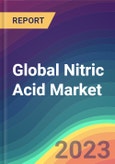Nitric Acid is a colorless acid with the chemical formula HNO₃. This is a mineral acid and an inorganic compound. The highly caustic substance is used extensively in the manufacture of ammonium nitrate and other compounds for fertilizer formulation. The substance is also employed in the manufacturing of compounds including nitrobenzene, adipic acid, and chloronitrobenzene. Other applications for these compounds include the construction, automotive, and plastics sectors. The growing demand for the fertilizer industry coupled with new technologies such as smart farming and precision agriculture is expected to drive the demand for nitric acid during the forecast period. Moreover, the growing demand for green fertilizers and organic farming is expected to hinder the demand growth during the forecast period. The size of the global Nitric Acid market is estimated to reach a volume of 70 million tonnes by 2032.
Based on region, Europe is dominating the Nitric Acid market. In 2022, Europe held a market share approximately of 50% of the global Nitric Acid. Numerous industries such as Fertilizer and Building & Construction are creating the demand for nitric acid in Europe. Furthermore, Asia Pacific is the second largest consumer of this acid. With the growing fertilizers demand in emerging economies like India and China coupled with increasing population growth is creating a huge demand in the Asia Pacific region. However, Asia Pacific dominates the market in terms of production with China being a significant player.
Based on type, the global Nitric Acid market is divided into Dilute Nitric Acid and Concentrated Nitric Acid. As of 2022, Dilute Nitric Acid is dominating the market with a share of roughly 67% 2022.
Based on the end-user industry, the global Nitric Acid market is segmented into Ammonium Nitrate, Adipic Acid, Toluene Di-Isocyanate, Nitrobenzene, and Others. Among these, Ammonium Nitrate is the major consumer with a share of roughly 70% in 2022. Ammonium Nitrate is used as fertilizer and in the production of fertilizer solutions such as urea ammonium nitrate, with most of the remaining being consumed in manufacturing various types of explosives. Adipic Acid is of high importance in the polymer industry and is required for manufacturing nylon 6,6. Toluene Di-Isocyanate is mainly employed in the manufacture of flexible polyurethane foams, used in applications for transportation, furniture, and carpet underlay.
Major players in the production of Global Nitric Acid are Yara International ASA, Grupa Azoty S.A, BASF SE, TKG Huchems, Azot(PJSC), Deepak Fertilizers and Petrochemicals Corporation Limited, Navoiyazot , OCI Nitrogen B.V, Sasol Nitro, JSC Minudobreniya, Fertiberia, LSB Industries (EI Dorado ), Abu Qir Fertilizer Egypt Co., Nutrien Ltd, Egyptian Chemical Industries (KIMA), CF Industries Holding Inc, Orica Australia Pty. Ltd., and Others.
Years considered for this report:
- Historical Period: 2015- 2022
- Base Year: 2022
- Estimated Year: 2023
- Forecast Period: 2024-2032
Objective of the Study:
- To assess the demand-supply scenario of Nitric Acid which covers production, demand and supply of Nitric Acid market in the globe.
- To analyse and forecast the market size of Nitric Acid
- To classify and forecast Global Nitric Acid market based on end-use and regional distribution.
- To examine competitive developments such as expansions, mergers & acquisitions, etc., of Nitric Acid market in the globe.
The publisher calculated Nitric Acid demand in the globe by analyzing the historical data and demand forecast which was carried out considering the production of raw material to produce Nitric Acid. The publisher sourced these values from industry experts and company representatives and externally validated through analyzing historical sales data of respective manufacturers to arrive at the overall market size. Various secondary sources such as company websites, association reports, annual reports, etc., were also studied by the publisher.
Key Target Audience:
- Nitric Acid manufacturers and other stakeholders
- Organizations, forums and alliances related to Nitric Acid distribution
- Government bodies such as regulating authorities and policy makers
- Market research organizations and consulting companies
Report Scope:
In this report, Global Nitric Acid market has been segmented into following categories, in addition to the industry trends which have also been detailed below:- Market, by Type: Dilute Nitric Acid and Concentrated Nitric Acid
- Market, by End-use: Ammonium Nitrate, Adipic Acid, Toluene Di-Isocyanate, Nitrobenzene, and Others
- Market, by Sales Channel: Direct Sale and Indirect Sale
- Market, by Region: North America, Europe, Asia Pacific, Middle East and Africa, and South America.








